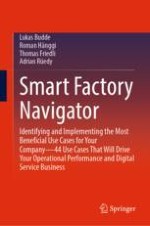The digitization of factories promises great potential benefits. The implementation of the various technologies for the smart factory is extremely complex, requires new competencies and necessitates significant investments. The question is: How can an industrial company successfully manage this transformation? For this purpose, more than 500 published use cases were screened. These could be categorized into 44 relevant use cases, which we describe in detail in the book. Our research has also shown that strategy and goal orientation must be at the core of the change. Furthermore, the combination of employee knowledge and use of technology is central to success. This led to the creation of our smart factory implementation approach. In various research and consulting projects we were able to apply this process and realize successful implementations in different companies. This 7-step process starts with the selection of promising use cases, followed by a prioritization step, adaptation to the company-specific context and a detailing of the information needs for the different management levels. Stringent project management helps the user achieve positive results that can then be rolled out on a global scale. This process is not only applicable to the "actual factory" but can also be used to design smart services for the factory of tomorrow.
Content
Smart factory definition and characterization · The smart factory navigator · The smart factory framework · Description of the 44 use cases for the smart factory · Technology mapping in relation to the 44 use cases · Smart factory implementation process · Smart services for the smart factory
